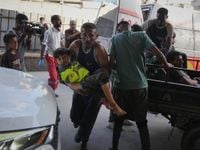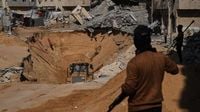Gaza’s already precarious ceasefire found itself on the brink of collapse on Sunday, October 19, 2025, as Israeli forces launched a series of deadly air strikes across the territory. The strikes came in response to what Israel described as a “blatant violation” of the truce, alleging that Hamas militants had killed two Israeli soldiers in Rafah, southern Gaza. The events marked the most violent day since the U.S.-brokered ceasefire began just over a week ago, raising fears that all-out war could return to the devastated enclave.
According to the BBC, the Israeli military stated that “terrorists fired an anti-tank missile and gunfire toward IDF troops operating to dismantle terrorist infrastructure in the Rafah area, in southern Gaza.” In response, Israeli forces struck dozens of targets throughout Gaza, including central and southern regions. Hospital sources reported at least 44 Palestinians killed, with Gaza’s Health Ministry confirming that children were among the dead. The ministry, part of the Hamas-run government, said at least 36 Palestinians lost their lives in the initial wave of strikes, with subsequent attacks pushing the toll higher as the night wore on.
Residents described scenes of chaos and panic. In Khan Younis, a series of at least 12 air strikes created what witnesses called a “fire belt,” sending plumes of smoke above the city and terrifying displaced families sheltering nearby. According to Al Jazeera, a strike on a makeshift coffeehouse in Zawaida killed at least six Palestinians, including members of Hamas’s al-Qassam Brigades. Among them was Yahya al-Mabhouh, a commander in Hamas’s elite Jabalia Battalion—a significant loss for the group since the ceasefire began. In Beit Lahiya in the north, two men were killed, while a tent sheltering civilians in the Muwasi area of Khan Younis was also hit, resulting in the deaths of a woman and two children, as reported by Nasser Hospital.
Amid the violence, the fragile ceasefire was briefly abandoned. The Israeli military announced a halt to aid deliveries into Gaza, further raising alarms among the population. However, enforcement of the truce resumed later that evening, with Israeli officials confirming that humanitarian aid would once again flow into the territory starting Monday. The official, who spoke anonymously to the Associated Press, said, “Aid deliveries will resume Monday.”
Prime Minister Benjamin Netanyahu directed the military to act “forcefully against terrorist targets in the Gaza Strip,” but stopped short of threatening a full return to war. His office identified the two soldiers killed in Rafah as Major Yaniv Kola and Sergeant Itay Yavetz. Netanyahu’s response underscored the tense balancing act: demonstrating resolve in the face of attacks, while not fully abandoning the ceasefire that international mediators, including the United States and Egypt, had worked so hard to broker.
The truce, which began on October 10, 2025, was intended to bring an end to two years of war and included a partial withdrawal of Israeli troops to a so-called “yellow line” along Gaza’s borders. It also called for Hamas to relinquish its weapons and for the gradual return of hostages and detainees on both sides. Under the deal, Hamas released all living hostages and the remains of 12 out of 28 deceased, while Israel freed 250 Palestinian prisoners and 1,718 detainees from Gaza, returning 15 bodies of Palestinians for each Israeli hostage’s remains. The BBC noted that the agreement was “put to the test on Sunday,” as violence flared and the mechanisms for prisoner and body exchanges became entangled in the renewed hostilities.
Hamas, for its part, denied responsibility for the attack on Israeli troops in Rafah. Its military wing, the al-Qassam Brigades, stated, “Contact with our remaining groups there has been cut off since the resumption of war in March of this year. Therefore, we have no connection to any events taking place in those areas, and we cannot communicate with any of our fighters there, if any of them are still alive.” Hamas also accused Israel of arming criminal gangs in the half of Gaza it controls, suggesting that the violence could be the result of internal rivalries rather than a coordinated attack by its own fighters.
As the day’s violence unfolded, a senior Egyptian official involved in the ceasefire negotiations told AP that “round-the-clock” contacts were underway to de-escalate the situation. The official, who was not authorized to speak publicly, said efforts were being made to prevent a total collapse of the truce. Meanwhile, a Hamas delegation led by chief negotiator Khalil al-Hayya arrived in Cairo to follow up on the implementation of the ceasefire deal with mediators and other Palestinian groups. The next stages of negotiation are expected to focus on disarming Hamas, further Israeli withdrawal, and the future governance of Gaza, with the U.S. plan proposing an internationally backed authority to take charge.
The humanitarian situation in Gaza remains dire. Palestinians fear that renewed fighting will plunge the territory, already suffering from famine and destruction, into an even deeper nightmare. “It will be a nightmare,” said Mahmoud Hashim, a father of five from Gaza City, in an appeal to U.S. President Donald Trump and other mediators. Hospitals are overwhelmed, and the Health Ministry has posted photos of unidentified bodies on its website to help families locate loved ones. Only 25 of the 150 bodies returned by Israel have been identified, with many decomposed or missing limbs.
The war, triggered by the October 7, 2023, Hamas-led attack on southern Israel that killed about 1,200 people and saw 251 hostages taken, has exacted a staggering toll. According to Gaza’s Health Ministry, at least 68,000 Palestinians have been killed by Israeli attacks since the conflict began. The ministry’s figures are viewed as generally reliable by UN agencies and independent experts, though Israel disputes the numbers without providing its own data. Thousands more remain missing, according to the Red Cross.
International attention is now focused on the ceasefire’s survival. American pressure is seen as crucial, with Trump’s envoy Steve Witkoff and his son-in-law Jared Kushner reportedly heading to Israel to help keep the deal on track. The U.S. State Department recently warned of “credible reports” that Hamas was planning an imminent attack on civilians in Gaza, a claim Hamas has denied. Trump himself has warned that if Hamas continues to kill people in Gaza, “we will have no choice but to go in and kill them,” though he later clarified he would not send U.S. troops into the territory.
As the sun set on October 19, the ceasefire was bruised but not broken. Both sides traded accusations and warnings, and families across Gaza and Israel braced for what might come next. The world, meanwhile, watched anxiously, hoping that diplomacy could once again pull the region back from the edge.





